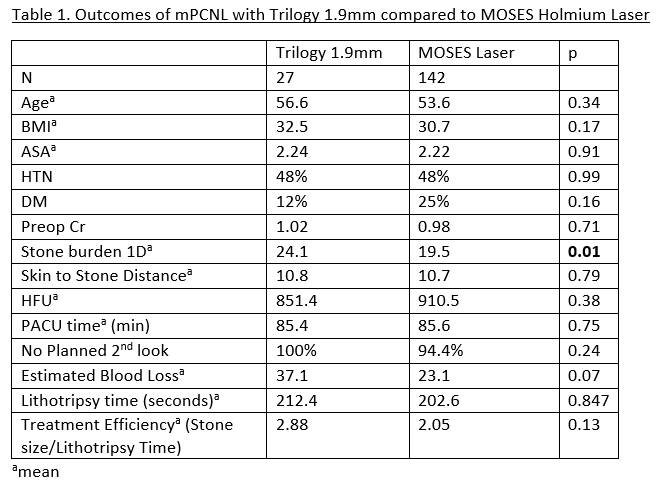Back
Poster, Podium & Video Sessions
Moderated Poster
MP32: Surgical Technology & Simulation: Instrumentation & Technology I
MP32-01: Comparison of 1.9mm Trilogy Probe and MOSES Holmium Laser In Mini-Percutaneous Nephrolithotomy
Saturday, May 14, 2022
2:45 PM – 4:00 PM
Location: Room 225
Daniel Rosen*, Hanover, MD, Max Drescher, Baltimore, MD, Julio Davalos, Hanover, MD

Daniel C. Rosen, MD
Chesapeake Urology
Poster Presenter(s)
Introduction: Mini-Percutaneous Nephrolithotomy (mPCNL) utilizes a smaller tract size inherently limiting the diameter of the lithotripter that can be accommodated through the nephroscope while maintaining adequate fluid inflow. To compensate for the loss of sheath diameter compared to standard PCNL, a premium is placed on efficient and effective lithotripsy. We sought to evaluate and optimize the usage of the 1.9mm Trilogy probe (a larger probe compared to the available 1.5mm probe) compared to the MOSES Holmium Laser for treatment efficiency during mPCNL.
Methods: We prospectively analyzed patients who underwent mPCNL from September-October 2021 and compared outcomes to our database of mPCNL performed with MOSES Holmium Laser from 2019 – 2021. The Storz 12Fr French nephroscope with the 16.5/17.5 Fr access sheath was used for both lithotripsy modalities. Demographic, preoperative, and postoperative data was prospectively collected. Stone volume was calculated both as the dominant single plane size as well as using 3D modeling with 3D Slicer. Treatment efficiency was calculated as stone size/treatment time. Fischer’s exact test and two tailed t tests were used for statistical analysis.
Results: 27 consecutive patients who underwent mPCNL with the 1.9mm Trilogy probe were compared to 142 consecutive mPCNL patients who had undergone treatment with laser. Demographics and outcomes data is displayed in Table 1. The Trilogy 1.9mm probe was found to be overall comparable to the MOSES Holmium laser, with an average 3D stone burden removed of 455.8mm3, and 3D efficiency 34.2 mm3/min. Patients undergoing mPCNL with 1.9mm had larger stone sizes (24mm vs 19mm, p<.01) though this did not lead to a statistically significant change in lithotripsy time or efficiency.
Conclusions: The 1.9mm Trilogy lithotripter presents an efficient alternative to laser-based modalities for mPCNL potentially allowing for the treatment of even larger stones with comparable lithotripsy times. Effective usage of retrograde and antegrade irrigation offers excellent visibility and efficient stone extraction allowing significant stone burdens to be treated using either modality requiring smaller tract size and renal sheaths compared to standard PCNL.
Source of Funding: EMS provided the research probes for use in this study.

Methods: We prospectively analyzed patients who underwent mPCNL from September-October 2021 and compared outcomes to our database of mPCNL performed with MOSES Holmium Laser from 2019 – 2021. The Storz 12Fr French nephroscope with the 16.5/17.5 Fr access sheath was used for both lithotripsy modalities. Demographic, preoperative, and postoperative data was prospectively collected. Stone volume was calculated both as the dominant single plane size as well as using 3D modeling with 3D Slicer. Treatment efficiency was calculated as stone size/treatment time. Fischer’s exact test and two tailed t tests were used for statistical analysis.
Results: 27 consecutive patients who underwent mPCNL with the 1.9mm Trilogy probe were compared to 142 consecutive mPCNL patients who had undergone treatment with laser. Demographics and outcomes data is displayed in Table 1. The Trilogy 1.9mm probe was found to be overall comparable to the MOSES Holmium laser, with an average 3D stone burden removed of 455.8mm3, and 3D efficiency 34.2 mm3/min. Patients undergoing mPCNL with 1.9mm had larger stone sizes (24mm vs 19mm, p<.01) though this did not lead to a statistically significant change in lithotripsy time or efficiency.
Conclusions: The 1.9mm Trilogy lithotripter presents an efficient alternative to laser-based modalities for mPCNL potentially allowing for the treatment of even larger stones with comparable lithotripsy times. Effective usage of retrograde and antegrade irrigation offers excellent visibility and efficient stone extraction allowing significant stone burdens to be treated using either modality requiring smaller tract size and renal sheaths compared to standard PCNL.
Source of Funding: EMS provided the research probes for use in this study.


.jpg)
.jpg)